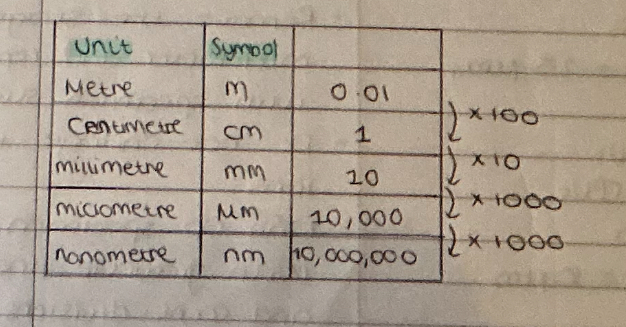2- Magnification and resolution
1/7
There's no tags or description
Looks like no tags are added yet.
Name | Mastery | Learn | Test | Matching | Spaced |
|---|
No study sessions yet.
8 Terms
What is magnification?
A ratio
Number of times larger ab image appears compared to the size if the actual object
It doesn’t effect detail
What is resolution?
The ability to distinguish between structures
Limited by differentiation of light as it passes through samples and objects
Can be increased by using beams of electrons instead of light as electrons have a shorter wavelength
Working out magnification
Actual size= image size / magnification
Cells normally measured in micrometers (μm)
Ultrastructure usually measured in nano metes (nm)
Units of measurement
The unit of measurement must be appropriate to the object being measured

Calibrating a microscope
To measure the size of a sample under a microscope it needs to be calibrated
True magnification of different lenses varies so every microscope needs to be calibrated, lenses too
This is done by using an eyepiece graticule and stage micrometer
A microscope eyepiece is fitted with a graticule
Stage micrometer
Placed on microscope stage
Ruler is 1mm (1000μm) long with 100 divisions so each division is 10 μm
Calculating conversion factor
You havre to do this for each objective lens you use
On x40:
1mm =40 EPUs
1000μm= 40 EPUs
1000/40 =25 25
Each division = 25 μm
On x100:
1mm =100 EPUs
1000μm= 100 EPUs
1000/100=10
Each division = 10μm
On x400:
0.25 mm=100 EPUs
250μm= 100 EPUs
250/100 =2.5
Each division = 2.5 μm
EPU- eyepiece unit
Once calibrated
Remove stage micrometer and replace with specimen slide
Don’t change the lens
Line up specimen with graticule lines and count divisions
Multiply by the conversion factor (what each division is worth in μm)